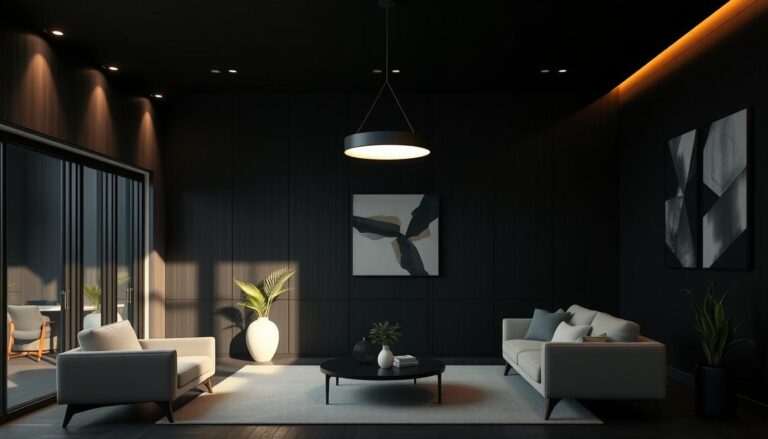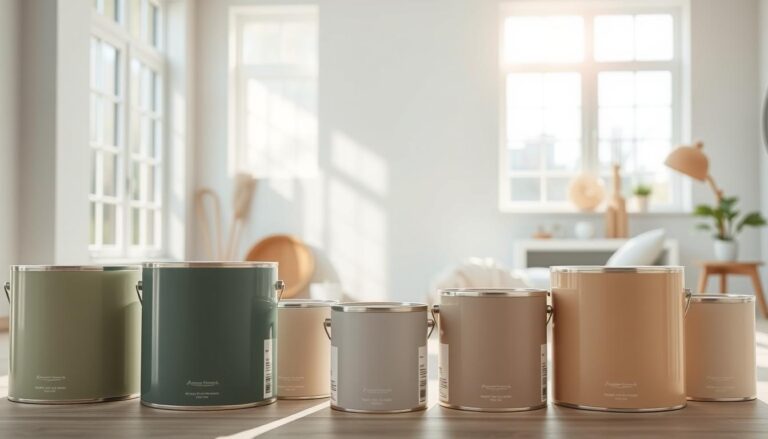Biophilic design is a way to connect our homes with nature. It uses natural materials, lots of light, plants, and organic textures. This approach makes our living spaces better for our minds, bodies, and spirits.
By adding biophilic design to your home, you can improve your health. Studies show that plants can lower stress and boost productivity. So, you can make your home pretty and good for you.
Exploring biophilic design, you’ll find many benefits. It can make your air cleaner and your mood better. Whether you want a calm place or a productive area, biophilic design can help. It focuses on natural elements, light, and textures to bring nature into your home.
Key Takeaways
- Biophilic design is a lifestyle choice that bridges the gap between nature and the modern built environment.
- Incorporating natural elements, such as plants and natural materials, can improve mental and physical health.
- Exposure to natural elements can increase productivity levels and reduce stress and anxiety.
- Biophilic design can increase feelings of happiness and relaxation, creating a peaceful and calming living space.
- Bringing nature into your home decor and lifestyle can have a significant impact on your overall well-being.
- Biophilic design is a great way to create a nature-inspired decor that promotes well-being and happiness.
- Incorporating biophilic design elements can increase home value and reduce energy consumption.
Understanding Biophilic Design: A Natural Connection
Biophilic design connects our homes to nature, bringing the outdoors inside. It’s based on biophilia, our need to be with other living things. By adding nature to our homes, we can feel more in tune with the world around us.
Biophilic design offers many benefits. It can make us feel better mentally and physically. It also improves the air we breathe and brings a sense of peace. To get these benefits, we need to use natural materials like wood and stone. We should also let in lots of natural light and use colors that remind us of nature.
Some key elements of biophilic design include:
- Natural materials, such as wood and stone
- Abundant natural light
- Organic textures and patterns
- Living elements, such as plants and water features
By adding these elements and following biophilic tips, we can make our homes better for our health. We can also grow to love nature more.
| Biophilic Design Element | Benefits |
|---|---|
| Natural Materials | Improved air quality, reduced stress |
| Natural Light | Improved mood, increased productivity |
| Organic Textures and Patterns | Enhanced sense of calm, reduced anxiety |
The Physical and Mental Benefits of Living with Nature
Biophilic interior design boosts both physical and mental health. It uses natural elements like plants, light, and textures. This creates a space that makes us feel better and less stressed. Natural elements also clean the air, cut down noise, and keep us comfortable, making our homes healthier.
Some key benefits of biophilic design include:
- Less stress and a happier mood
- Better thinking and more productivity
- Deeper sleep and overall better health
These advantages are vital, as about 22.8% of U.S. adults had mental illness in 2021. Also, over 20 million adults had anxiety in the U.S. in 2019. By using biophilic design, people can make homes that help their mental health.
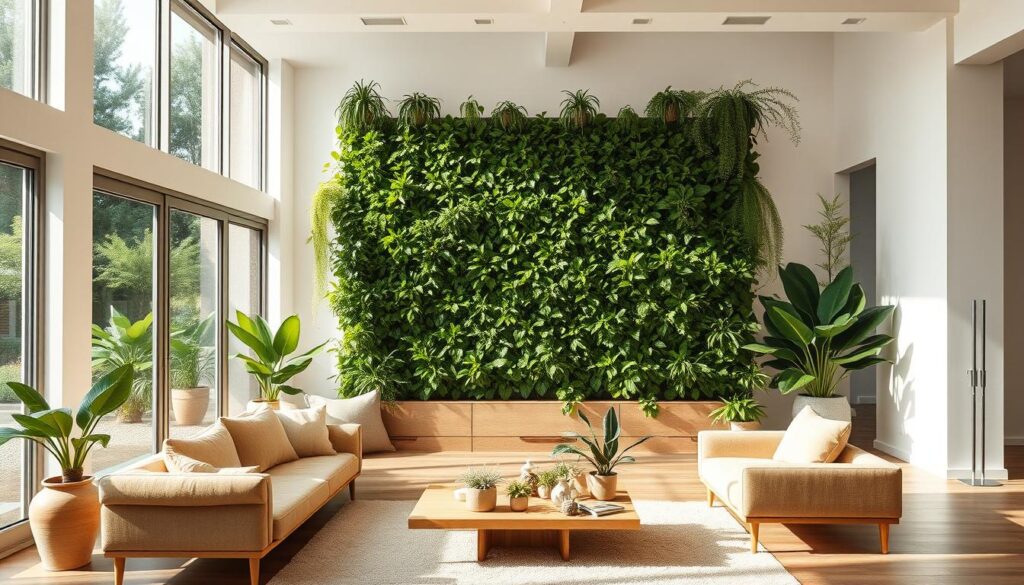
Research shows biophilic design helps those with depression and anxiety. It makes homes feel calming, helping people manage their conditions. As mental health awareness grows, more people are choosing biophilic design for a healthier home.
| Benefits of Biophilic Design | Physical Health Benefits | Mental Health Benefits |
|---|---|---|
| Improved air quality | Reduced risk of respiratory diseases | Improved mood and reduced stress |
| Natural light | Improved vitamin D levels | Improved cognitive functioning and productivity |
| Organic textures | Improved thermal comfort | Reduced anxiety and improved sleep quality |
Essential Elements of Biophilic Design in Home Interiors
Biophilic architecture and green home designs are gaining popularity. They bring natural elements into homes, improving mental health and productivity. Key elements include natural light, organic materials, plants, and natural colors.
These elements can be added in many ways. For example:
- Large windows and skylights for natural light
- Organic materials like wood and stone
- Plants and green walls for air purification and calm
- Natural colors and patterns for harmony
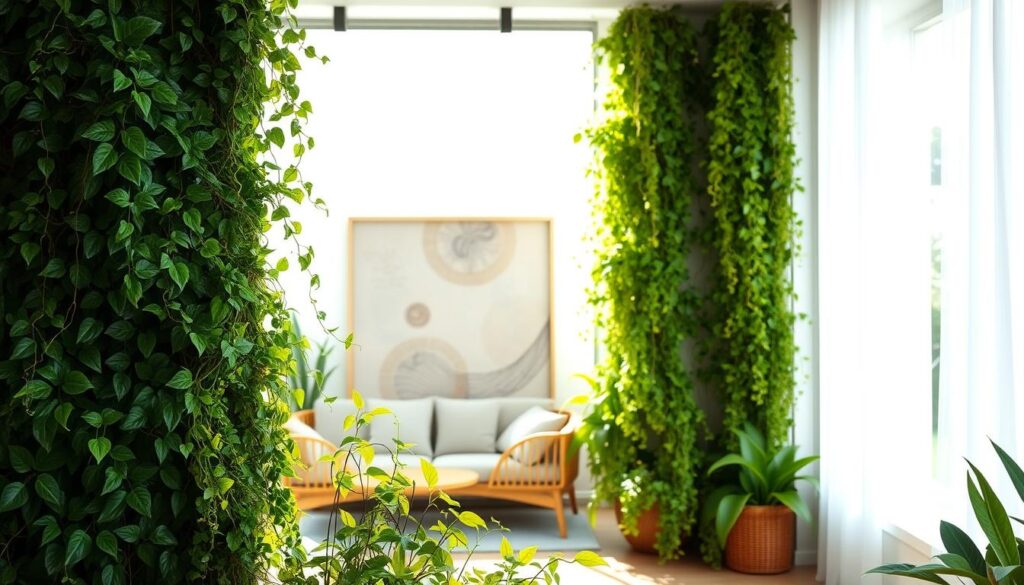
By adding these elements, homes become healthier and more beautiful. As people seek sustainable living, biophilic design will keep growing.
| Element | Benefit |
|---|---|
| Natural Light and Ventilation | Improves mood and energy levels |
| Organic Materials and Textures | Creates a sense of warmth and authenticity |
| Living Elements and Plant Integration | Purifies the air and creates a sense of calm |
| Natural Colors and Patterns | Creates a sense of harmony and balance |
Creating Your Biophilic Design Strategy
Creating a biophilic design strategy means looking at your living space and finding ways to add natural elements. This could be as easy as adding plants, using natural materials, or letting in more natural light. By bringing nature into your home decor, you can make a space that’s good for your mind, body, and spirit.
Biophilic design has many benefits. It can improve air quality, boost productivity, and make you feel better overall. For instance, studies show that spaces with biophilic design can reduce absenteeism by 13% and increase productivity by 25%. People also see a 50% boost in well-being when natural elements are part of their environment.
To start, think about these tips:
- Look at your lighting, materials, and textures. Find ways to add more natural light, organic materials, and living things.
- Think about how to make your space feel harmonious and balanced.
- Choose natural elements that match your style and needs.
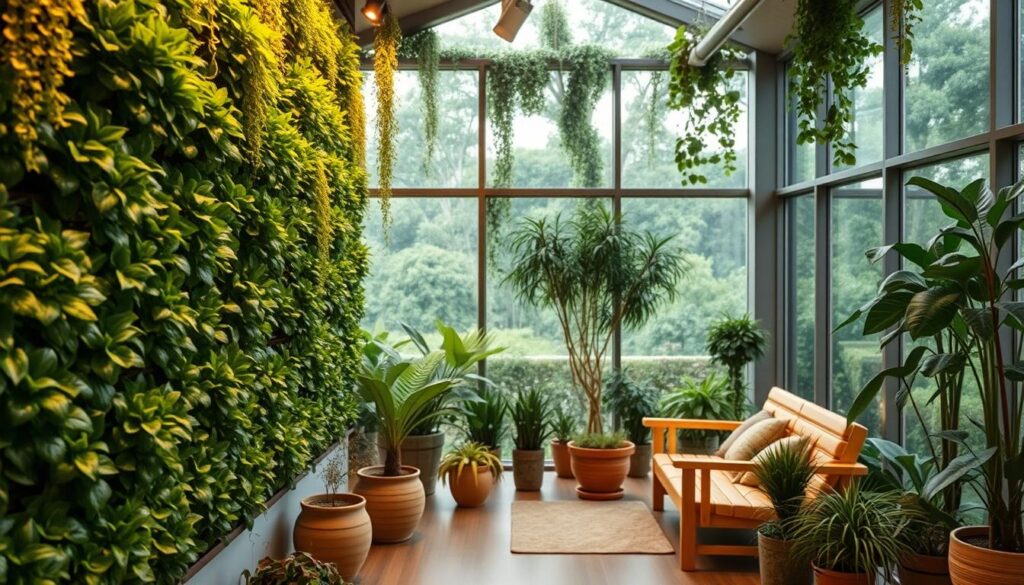
By making a biophilic design plan, you can make a space that’s not just pretty but also good for your well-being. Remember to bring nature into your home decor in a way that feels real and meaningful to you. Don’t be afraid to try new things and see what works best for you.
| Benefits of Biophilic Design | Percentage Improvement |
|---|---|
| Productivity | 25% |
| Absenteeism | 13% |
| Overall Well-being | 50% |
Room-by-Room Guide to Nature-Inspired Decor
Every room in your home is a chance to connect with nature. By using nature in your design, you can make a space that’s good for your health and helps you focus.
A room designed well can really affect your mood and health. For instance, natural light exposure can make you 15% more productive indoors. Here are some ideas for each room:
Living Room: The Heart of Natural Design
The living room is a key spot for natural design. It should have lots of natural light, organic materials, and plants. Adding plants, a water feature, or a natural fiber rug can make it cozy and welcoming.
Bedroom: Creating a Natural Sanctuary
Make your bedroom a peaceful haven. Use calm colors, natural textures, and soft sounds. This can make you 25% more relaxed and calm.
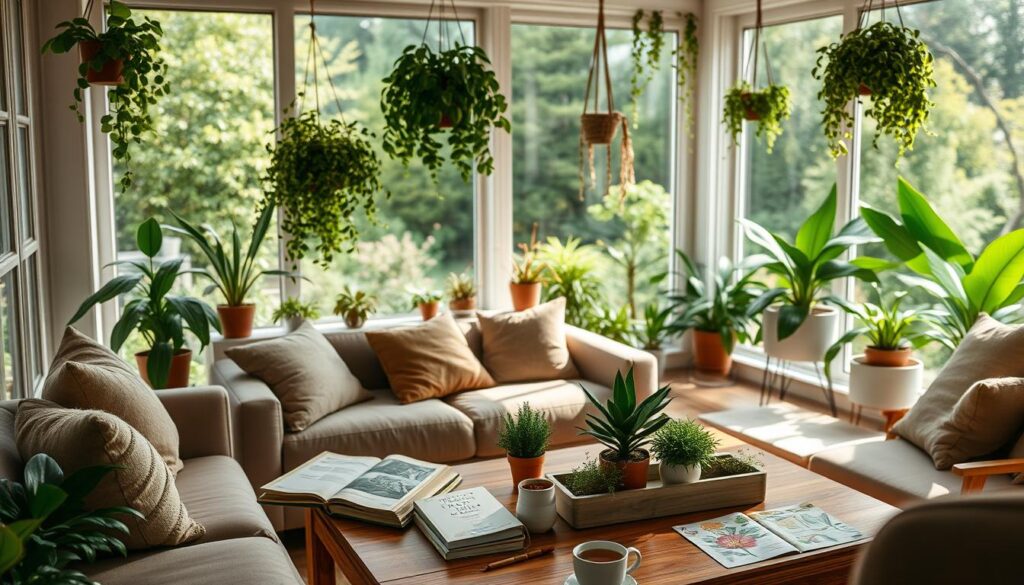
Kitchen: Bringing the Garden Inside
Turn your kitchen into a mini garden. Use natural light, organic materials, and plants. Adding a herb garden or a living wall can make it feel fresh and natural.
Bathroom: A Spa-Like Natural Retreat
Transform your bathroom into a spa. Focus on natural materials, calming colors, and soothing sounds. This can increase your relaxation time by 40%, improving your overall well-being.
Sustainable Materials and Eco-Friendly Choices
Choosing sustainable materials is key in biophilic interior design. It helps reduce environmental harm and makes your home healthier. Materials like reclaimed wood, bamboo, and low-VOC paints are great choices.
Adding natural elements in home decor means using local and raw materials. This links biophilic design with sustainability. Salvaged stone and reclaimed wood, for example, bring character and support the environment.
Here are some eco-friendly options to think about:
- Using indigenous foliage to reduce carbon footprint
- Incorporating terracotta and recycled-plastic pots
- Maximizing natural light exposure in north-facing homes
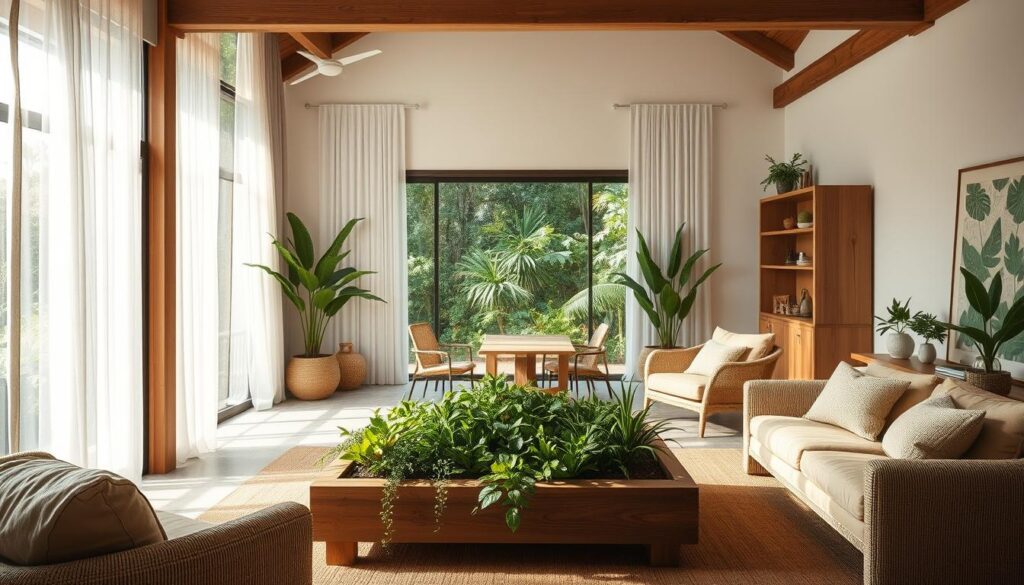
These choices help lessen your environmental footprint and make your home healthier. For instance, natural light can cut down artificial lighting needs by 50%. Adding plants can also boost air quality by up to 50%.
| Material | Benefits |
|---|---|
| Reclaimed Wood | Reduces environmental degradation, conserves energy |
| Bamboo | Sustainable, durable, and resistant to pests |
| Low-VOC Paints | Improves indoor air quality, reduces health risks |
Incorporating Living Walls and Indoor Gardens
Living walls and indoor gardens are key in biophilic architecture. They let people connect with nature indoors. These features can clean the air, lower noise, and bring calm. They are vital in green home designs.
By adding living walls and gardens, homes become places of peace and growth. They support the mind, body, and spirit.
Some benefits of living walls and indoor gardens include:
- Reduced indoor air pollutants by approximately 50%
- Improved cognitive function by up to 20%
- Enhanced aesthetic appeal, leading to a 14% increase in property value
When setting up an indoor garden, think about upkeep like watering and pruning. Living walls and gardens boost well-being and property value. 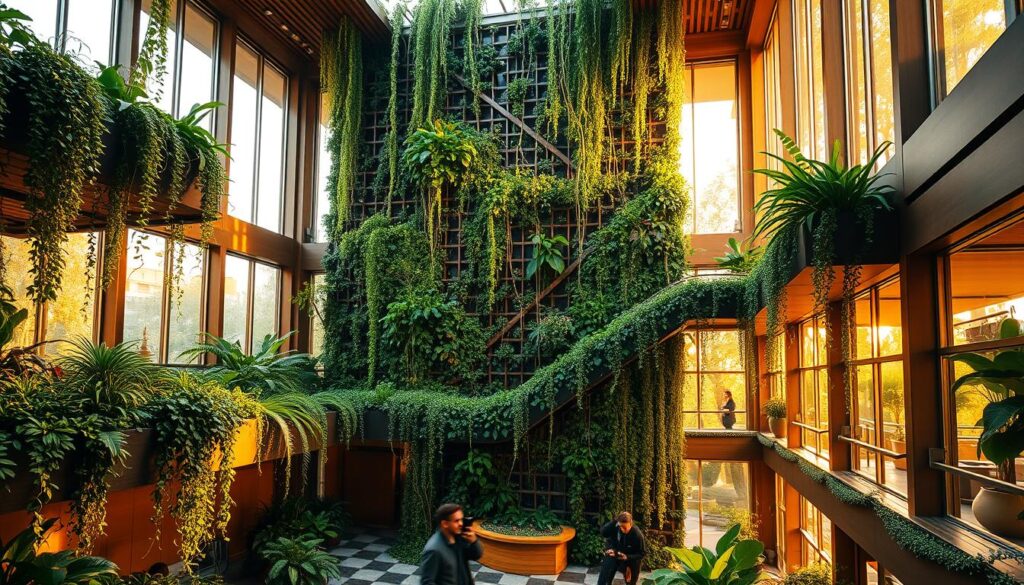
| Benefits | Percentage Improvement |
|---|---|
| Reduced indoor air pollutants | 50% |
| Improved cognitive function | 20% |
| Increased property value | 14% |
Biophilic Design on a Budget
Biophilic design doesn’t have to cost a lot. You can use affordable natural elements and DIY projects to bring nature into your home. This way, you can make a space that’s good for you and your wallet.
Bringing nature into your home is key to biophilic design. You can do this with simple, cheap ideas. For example, using plants, branches, and stones can add a natural feel without spending a lot. DIY projects like terrariums or living walls are also budget-friendly ways to add biophilic design to your home.
Cost-Effective Natural Elements
Here are some affordable natural elements to consider:
- Plants: They clean the air and add green to your space.
- Natural stone: It brings warmth and texture to your area.
- Reclaimed wood: It gives your space a unique, eco-friendly touch.
DIY Nature-Inspired Projects
DIY projects are a fun way to get creative with biophilic design on a budget. Try these ideas:
- Make a living wall with a trellis or wooden board.
- Build a terrarium in a glass container with some plants.
- Grow your own plants to expand your collection without spending more.
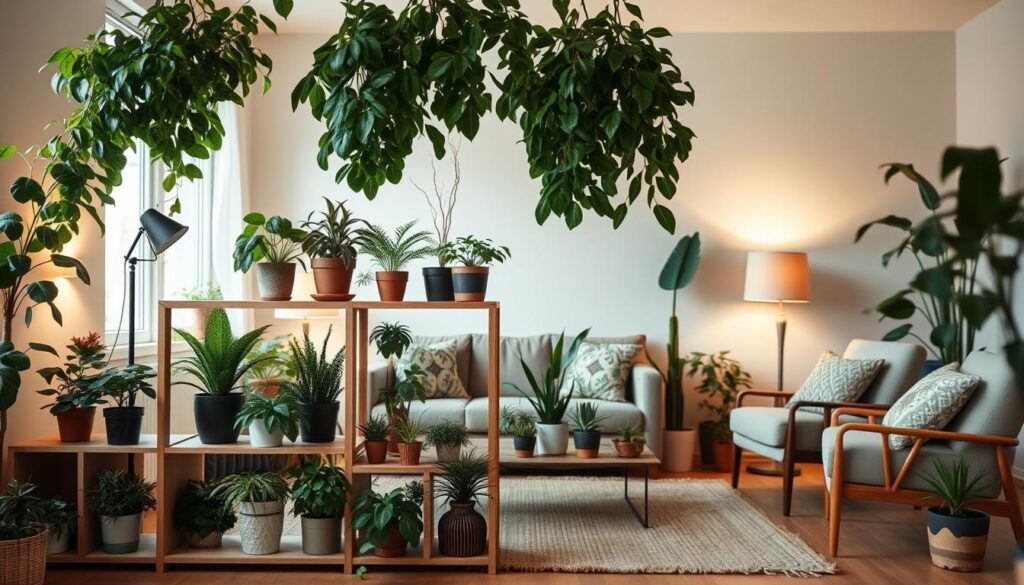
By using these affordable natural elements and DIY projects, you can create a space that’s good for you and your wallet. It connects you with nature while staying within your budget.
Seasonal Updates for Your Biophilic Space
To keep your biophilic design fresh, think about seasonal updates. You can change plants, colors, and textures to match the season. Incorporating nature in home design aims to bring harmony and balance indoors. Seasonal updates make your space lively and caring.
Here are some biophilic lifestyle tips for seasonal changes:
- Adding seasonal flowers or branches to your decor
- Changing the color palette to reflect the current season
- Incorporating natural textures, such as wool or cotton, into your furniture and decor
These updates make your biophilic space not just pretty but also good for your well-being. 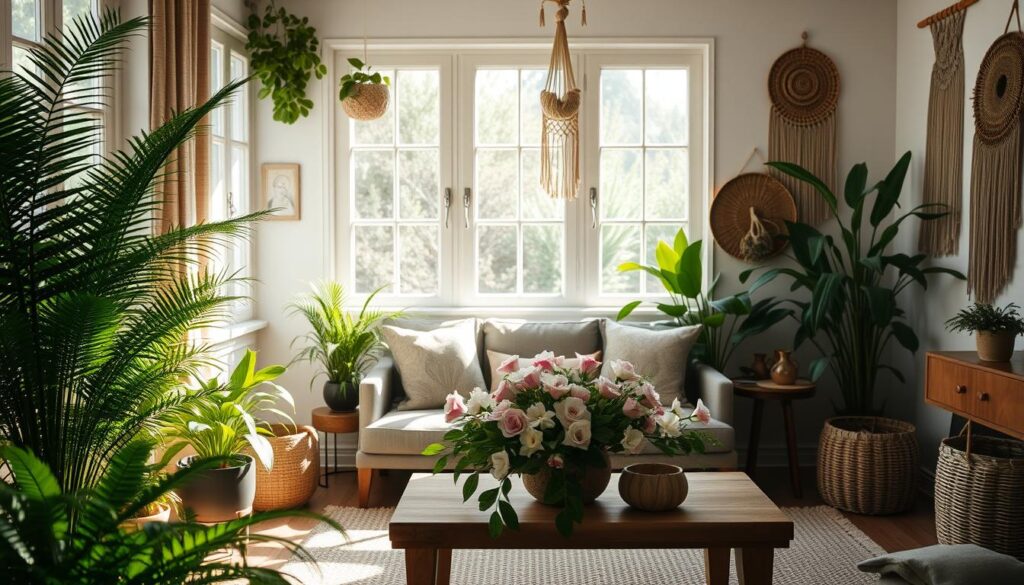
| Season | Biophilic Design Elements |
|---|---|
| Spring | Flowers, greenery, pastel colors |
| Summer | Bright colors, natural textures, outdoor furniture |
| Autumn | Warm colors, seasonal flowers, cozy textiles |
| Winter | Soft colors, natural materials, warm lighting |
Maintaining Your Nature-Inspired Home
To keep your biophilic interior design thriving, it’s key to have a care routine. This includes watering, pruning, and cleaning your plants and indoor garden. Doing these tasks daily or weekly helps you enjoy the benefits of biophilic design.
A well-maintained biophilic space boosts both physical and mental health. For example, studies have shown that nature can improve cognitive performance, mood, and sleep. Here are some tips to help:
- Create a care schedule for your plants and indoor garden
- Incorporate seasonal maintenance tasks, such as fertilizing and repotting
- Monitor and adjust the lighting and temperature in your space to optimize conditions for your natural elements
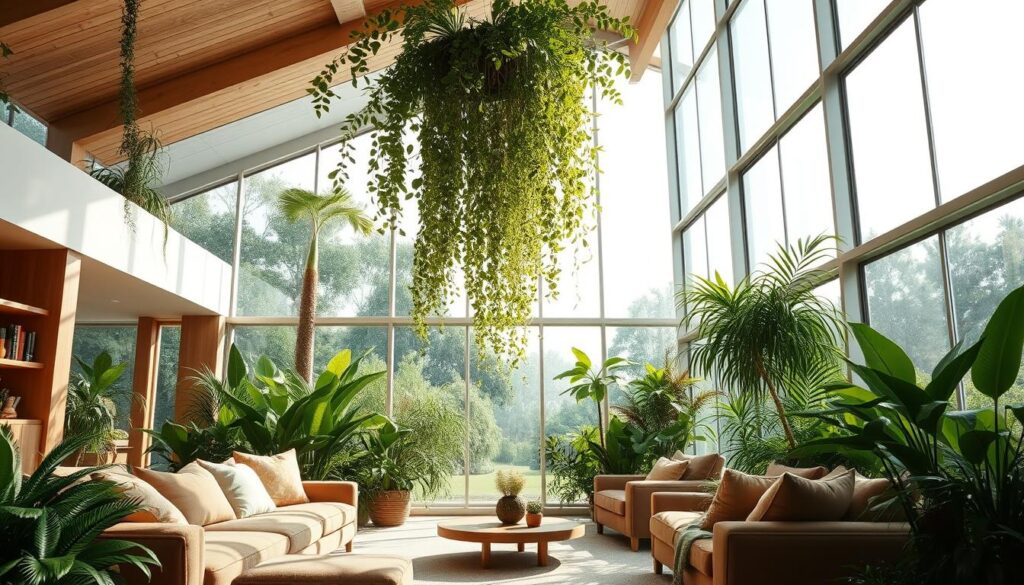
By following these guidelines and staying committed, you’ll enjoy the many benefits of biophilic design. Remember, a little effort preserves the beauty and tranquility of your space. The rewards are well worth it.
Conclusion: Embracing a Biophilic Lifestyle for Long-Term Well-being
As we wrap up our look at biophilic design, it’s clear that adding nature to our homes is key. By bringing nature into our home decor, we make a space that cares for our mind, body, and spirit.
Research shows that indoor plants can clean the air, lower stress, and boost work and creativity. Also, nature-inspired decor with natural materials and colors helps us relax and focus. From green walls to peaceful water sounds, we can make our homes into natural retreats.
Living a biophilic lifestyle helps us connect deeply with nature. This can be through gardening, meditation, or just enjoying the beauty around us. This path leads to a more balanced and joyful life, filled with nature’s wonders.

